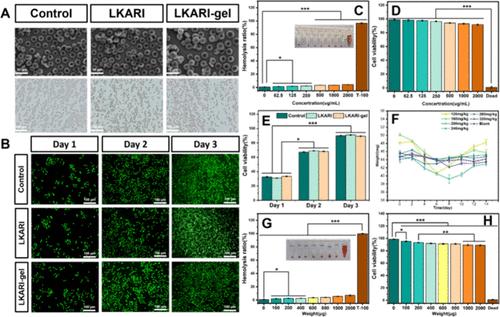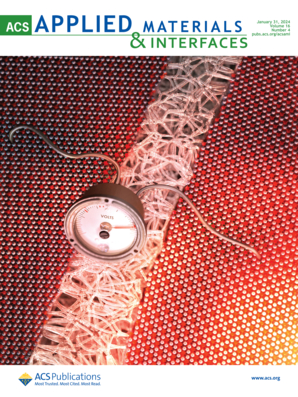对 "具有广谱杀菌特性的短链抗菌肽 LKARI 的筛选及其在促进伤口愈合中的应用 "的更正
IF 8.2
2区 材料科学
Q1 MATERIALS SCIENCE, MULTIDISCIPLINARY
引用次数: 0
摘要
在我们最初的文章中,出现了三个错误,它们都是由于在布局过程中不正确地放置图像造成的,如图3、4和9所示。同时,我们注意到图8中第11天和第14天的伤口愈合没有明显差异,因此我们删除了图8中第11天的伤口愈合图像。这些更正不影响原始出版物的结果和结论。所有作者都同意这些更正,并对错误表示诚挚的歉意。图3。抗菌肽链及抗菌水凝胶的生物相容性。图4。抗菌肽LKARI与青霉素-链霉素耐药性。图8。大肠杆菌和白色念珠菌感染模型的治疗。图9。愈合伤口病理分析。具体来说,图3A中lkarii -gel的血细胞SEM图像格式不正确。在图4B中,第8代板的图像被错误地复制为第6代板。在图9A中,由于命名错误,LKARI-gel +金黄色葡萄球菌组的肝脏H&;E染色组织图像被错误标记。这篇文章尚未被其他出版物引用。本文章由计算机程序翻译,如有差异,请以英文原文为准。

Correction to “Screening of Short-Chain Antimicrobial Peptide LKARI with Broad-Spectrum Bactericidal Properties and Its Application in Promoting Wound Healing”
In our original article, three errors appear, all of which were caused by incorrect placement of images during the layout process in Figures 3, 4 and 9. At the same time, we noticed that the wound healing at Day 11 and Day 14 in Figure 8 is not significantly different, so we have removed the wound healing image from Day 11 in Figure 8. These corrections do not affect the results and conclusions of the original publication. All authors agree with these corrections and sincerely apologize for the errors. Figure 3. Antibacterial peptide chain and biocompatibility of the antibacterial hydrogel. Figure 4. Antimicrobial peptide LKARI and penicillin–streptomycin resistance. Figure 8. Treatment of Escherichia coli and Candida albicans infection models. Figure 9. Pathological analysis of healing wound. Specifically, the SEM image of blood cells in Figure 3A for LKARI-gel was incorrectly formatted. In Figure 4B, the image for the 8th generation plate was mistakenly duplicated as the 6th generation plate. In Figure 9A, the liver H&E stained tissue image for the LKARI-gel + S. aureus group was incorrectly labeled due to a naming error. This article has not yet been cited by other publications.
求助全文
通过发布文献求助,成功后即可免费获取论文全文。
去求助
来源期刊

ACS Applied Materials & Interfaces
工程技术-材料科学:综合
CiteScore
16.00
自引率
6.30%
发文量
4978
审稿时长
1.8 months
期刊介绍:
ACS Applied Materials & Interfaces is a leading interdisciplinary journal that brings together chemists, engineers, physicists, and biologists to explore the development and utilization of newly-discovered materials and interfacial processes for specific applications. Our journal has experienced remarkable growth since its establishment in 2009, both in terms of the number of articles published and the impact of the research showcased. We are proud to foster a truly global community, with the majority of published articles originating from outside the United States, reflecting the rapid growth of applied research worldwide.
 求助内容:
求助内容: 应助结果提醒方式:
应助结果提醒方式:


